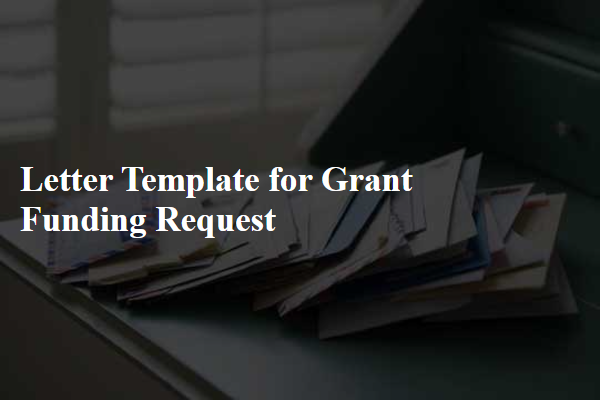Are you looking to make a meaningful impact in your community through poverty alleviation? Crafting a compelling letter for a grant application can be the key to unlocking vital funding for your initiatives. In this article, we'll explore effective strategies and templates to help you convey your mission, articulate the needs of those you aim to help, and demonstrate the potential outcomes of your project. Join us as we dive deeper into the essential elements that can turn your grant proposal into a persuasive narrative worth funding!

Purpose and objectives of the grant
Poverty alleviation grants serve a crucial role in addressing socioeconomic disparities within communities, aiming to improve living conditions and provide sustainable solutions. The primary purpose is to fund programs that enhance access to education, healthcare, and vocational training, targeting underprivileged populations affected by systemic poverty. Objectives often include cultivating job opportunities through skills development workshops, establishing micro-financing initiatives to support small businesses, and improving access to essential services like clean water and affordable housing. These grants may also emphasize community engagement and empowerment, fostering local leadership to create long-term change and resilience against economic instability. By facilitating coordinated efforts among nonprofit organizations, government bodies, and private sector partners, these grants strive to create a holistic approach that addresses the multifaceted nature of poverty.
Eligibility criteria and target beneficiaries
A successful poverty alleviation grant application focuses on targeting vulnerable populations, such as low-income families, individuals experiencing homelessness, and marginalized communities. Eligibility criteria often include specific income thresholds, typically set at or below 200% of the federal poverty level, which varies based on family size across different regions in the United States. Documentation such as proof of income, residency verification, and demographic information may be required for beneficiaries to qualify. Additionally, the program might prioritize groups including single-parent households, individuals with disabilities, and those affected by systemic inequality, aiming to empower these populations through education, job training programs, and essential services like food assistance or housing support. Programs equipped to serve target beneficiaries often measure success through increased employment rates, improved access to education, and enhanced overall quality of life.
Application process and deadline
Poverty alleviation grants play a crucial role in empowering communities and providing needed resources for socio-economic development. Various organizations, including governmental and non-profit entities, often offer these grants to support initiatives aimed at reducing poverty levels. Applicants typically must submit detailed proposals outlining their project goals, target demographics, and expected outcomes by specific deadlines, which may vary widely depending on the funding source. For instance, many organizations may require proposals submitted by the end of the fiscal quarter, necessitating a keen understanding of the timeline. Additionally, successful applications often include metrics for measuring success, detailed budgets, and an outline of community involvement, demonstrating the commitment to sustainable development.
Funding amount and allocation specifics
Poverty alleviation initiatives can significantly impact communities by addressing the underlying issues contributing to socio-economic hardships. A proposed funding amount of $500,000 could be allocated to various programs targeting food security, education, and job training in underserved areas such as the Appalachian region and urban centers like Chicago. Specific allocations might include $200,000 for establishing community gardens to promote nutrition and self-sustainability, $150,000 for educational scholarships aimed at low-income students, and $150,000 to develop vocational training programs that equip individuals with marketable skills for local industries, ultimately fostering economic independence. Implementing these targeted strategies can create sustainable pathways out of poverty for affected individuals and families.
Evaluation and reporting requirements
In poverty alleviation initiatives, organizations must adhere to strict evaluation and reporting requirements to ensure transparency and accountability. These reports typically encompass quantitative data, including financial expenditures, demographic statistics, and participant outcomes. For instance, a common metric is reaching an annual target of reducing poverty levels by at least 10% in targeted communities, such as those in the Appalachian region of the United States. Qualitative assessments may also be required, providing personal testimonies from beneficiaries that illustrate the project's impact on their lives, such as improvements in education or access to healthcare. Additionally, organizations must document the use of funding, ensuring compliance with grant conditions set by entities like the U.S. Department of Health and Human Services. Timely and accurate reporting is vital, often necessitating submission on a semi-annual basis to maintain funding and support for ongoing programs.
Letter Template For Poverty Alleviation Grant Samples
Letter template of application for financial support in poverty reduction

Letter template of project funding request for poverty intervention strategies

Letter template of partnership proposal for collaborative poverty alleviation efforts











Comments